Mammals that became extinct in Ireland thousands of years ago

[cs_section id=”” class=” ” style=”margin: 0px; padding: 45px 0px; ” visibility=”” parallax=”false”][cs_row id=”” class=” ” style=”margin: 0px auto; padding: 0px; ” visibility=”” inner_container=”true” marginless_columns=”false” bg_color=””][cs_column id=”” class=”” style=”padding: 0px; ” bg_color=”” fade=”false” fade_animation=”in” fade_animation_offset=”45px” fade_duration=”750″ type=”1/1″] [/cs_column][/cs_row][/cs_section][cs_section id=”” class=” ” style=”margin: 0px; padding: 45px 0px; ” visibility=”” parallax=”false”][cs_row id=”” class=” ” style=”margin: 0px auto; padding: 0px; ” visibility=”” inner_container=”true” marginless_columns=”false” bg_color=””][cs_column id=”” class=”” style=”padding: 0px; ” bg_color=”” fade=”false” fade_animation=”in” fade_animation_offset=”45px” fade_duration=”750″ type=”1/1″][x_slider animation=”slide” slide_time=”7000″ slide_speed=”1000″ slideshow=”false” random=”false” control_nav=”false” prev_next_nav=”true” no_container=”false” ][x_slide]
The Irish Elk, (Megaloceros), is misnamed, for it is neither exclusively Irish nor is it an elk. It was a giant deer, the largest deer species ever, that stood up to seven feet at the shoulder (2.1 meters), with antlers spanning up to 12 feet (3.65 meters). The Irish elk evolved during the glacial periods of the last million years, during the Pleistocene Epoch. It ranged throughout Europe, northern Asia and northern Africa, and a related form is known from China. The name “Irish” has stuck because excellent, well-preserved fossils of the giant deer are especially common in lake sediments and peat bogs in Ireland[/x_slide][x_slide]
Unable to adapt to the subartic conditions of the last glaciation or the marked transition that occured after the final retreat of the ice sheet, the largest deer that ever lived became extinct, the last one in Ireland dying around 11,000 years ago. Megalocerosmay have possibly survived in continental Europe into historic times.
Beyond its arresting size and singular appearance, the giant deer is of great significance to paleontologists because of the way in which the animal has become involved in evolutionary debates down through the years.[/x_slide][x_slide]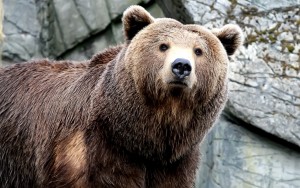
The brown bear (Ursus arctos) is a large bear still populating areas across much of northern Euraisa and North America and is the largest terrestrial carnivoran. The winter fur is very thick and long, especially in northern subspecies, and can reach 11 to 12 centimetres (4 to 5 in) at the withers. The winter hairs are thin, yet rough to the touch. The summer fur is much shorter and sparser, and its length and density varies geographically.[/x_slide][x_slide]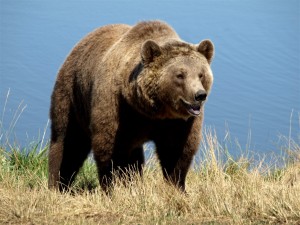
The brown bear was in Ireland when our hunter-gatherer forebears arrived 9,000 years ago. It became extinct four to six millennia later.
The brown bears in Ireland were highly unlikely to have survived the last ice age. Its predicted that extinction occurred very quickly during the last glaciation with the likelihood that the bears died out some time between 150 – 1500 years during the last ice age period.
A study of the DNA of ancient brown bear bones in Ireland proved that the maternal ancestors of modern polar bears were Irish. Conditions in Ireland at the end of the last ice age resembled those of Alaska today. Polar bears may have been stranded here and brown bears could have mated with them, accounting for the presence of their DNA sequences in some polar bears today. Our Irish bears were, in fact, brown-polar hybrids.
Evidence of the Irish brown bear has been found across the island of Ireland. The best examples can be found in the Poll na mBear (Cave of the Bears) in County Leitrim.[/x_slide][x_slide]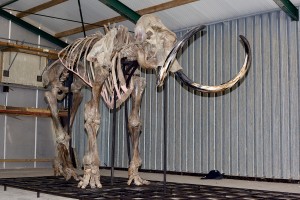
The woolly mammoth (Mammuthus primigenius) is a species of mammoth that lived during the Pleistocene epoch, and was one of the last in a line of mammoth species.
Believed to be closely related to the modern-day elephant, the woolly mammoth remained in the wild until roughly 1700 BC when it became extinct.
The woolly mammoth was an enormous animal, with adults often reaching heights of four meters or more. Woolly mammoths in certain areas where, on average slightly smaller in size and could in fact be just half the size of one of the largest woolly mammoth individuals.[/x_slide][x_slide]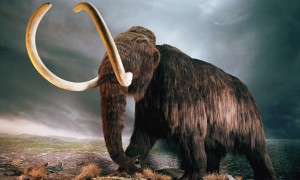
Most woolly mammoth populations disappeared during the late Pleistocene and early Holocene, alongside most of the Pleistocene megafauna. This extinction formed part of the Quaternary Extinction Event, which began 40,000 years ago and peaked between 14,000 and 11,500 years ago. Scientists are divided over whether hunting or climate change, which led to the shrinkage of its habitat, was the main factor that contributed to the extinction of the woolly mammoth, or whether it was due to a combination of the two. Whatever the cause, large mammals are generally more vulnerable than smaller ones due to their smaller population size and low reproduction rates. Different woolly mammoth populations did not die out simultaneously across their range, but gradually went extinct over time. Most populations disappeared between 14,000 and 10,000 years ago.
It is generally assumed that the last woolly mammoths vanished from Europe and Southern Siberia in around 8,000 BC, with the last of the isolated woolly mammoth populations vanishing from Wrangel Island, located in the Artic Ocean in around 1700 BC.[/x_slide][x_slide]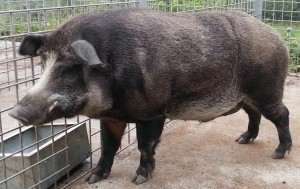
The wild boar (Sus scrofa), is a suid native to much of Eurasia, North Africa, and the Greater sunda Islands. Human intervention has spread its range further, making the species one of the widest-ranging mammals in the world, as well as the most widely spread suiform.
The species lives in matriarchal societies consisting of interrelated females and their young (both male and female). Fully grown males are usually solitary outside of the breeding season.[/x_slide][x_slide]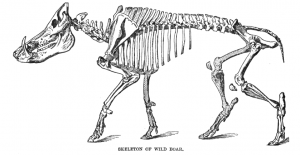
The wild boar became extinct in Ireland around 5,000 years ago. With today’s Ireland boasting a lot less forestry and a lot more farming, opinions are split over whether or not the animal should be re-introduced.[/x_slide][x_slide]
The reindeer (Rangifer tarandus) is a species of deer with circumpolar distribution, native to artic,subartic, tundra, boreal and mountainous regions of northern Europe, Siberia, and North America. This includes both sedentary and migratory populations.
Reindeer vary considerably in colour and size. In most populations, both sexes grow antlers annually, but females lack antlers in a few. Antlers are typically larger on males.[/x_slide][x_slide]
At present, we do not know much about the natural history of Irish reindeer population(s), but a new study between Irish and Norwegian scientists is hoping to shed more light on this enigmatic species.
Its presumed that after the last Ice Age, the climate in Ireland slowly became wetter and warmer (this happened between about 13,000 to 15,000 years ago) and these changes would have affected the availability of food for many faunal species, such as reindeer.[/x_slide][/x_slider][/cs_column][/cs_row][/cs_section][cs_section id=”” class=” ” style=”margin: 0px; padding: 45px 0px; ” visibility=”” parallax=”false”][cs_row id=”” class=” ” style=”margin: 0px auto; padding: 0px; ” visibility=”” inner_container=”true” marginless_columns=”false” bg_color=””][cs_column id=”” class=”” style=”padding: 0px; ” bg_color=”” fade=”false” fade_animation=”in” fade_animation_offset=”45px” fade_duration=”750″ type=”1/1″][x_author title=”About the Author” author_id=””][/cs_column][/cs_row][/cs_section]







